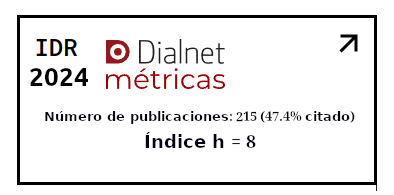Adaptación y validación al español del cuestionario de involucramiento en redes sociales digitales
Palabras clave:
Redes sociales; cuestionario; adaptación; validaciónResumen
En los últimos años, el estudio de la interacción digital se ha ido incrementando, dando lugar al planteo de nuevas problemáticas para abordar y estudiar. Como cualquier tipo de interacción, la digital tiene aspectos positivos y negativos, lo cual resulta de actual interés para las ciencias sociales. Pero hay muy pocos estudios, particularmente en América Latina, sobre como en la actualidad la interacción mediante redes sociales digitales afecta las formas de socialización y en cómo repercute sobre el tiempo que pasamos utilizándolas. Particularmente, el Cuestionario de Involucramiento con las Redes Sociales Digitales constituye una de las principales técnicas para medir efectivamente qué tan inmersos estamos en las redes sociales, tomando como referencia la frecuencia de uso que una persona realiza de las mismas en el transcurso de una semana. El presente trabajo se propone adaptar y validar la escala al contexto argentino en una muestra de 418 estudiantes de nivel medio con residencia en la Ciudad Autónoma de Buenos Aires (CABA). Los resultados obtenidos por el análisis factorial confirmatorio brindan soporte empírico al modelo, contribuyendo a la adaptación y validación del inventario para el contexto argentino.
Descargas
Citas
Alt, D. (2015). College students’ academic motivation, media engagement and fear of missing out. Computers in Human Behavior, 49. doi: 10.1016/j.chb.2015.02.057.
Apaolaza, V., Hartmann, P., D'Souza, C., y Gilsanz, A. (2019). Mindfulness, compulsive mobile social media use, and derived stress: The mediating roles of self-esteem and social anxiety. Cyberpsychology, Behavior, and Social Networking, 388-396. http://doi.org/10.1089/cyber.2018.0681.
Baker, Z., Krieger, H., y LeRoy, A. (2016). Fear of missing out: Relationships with depression, mindfulness, and physical symptoms. Translational Issues in Psychological Science, 2, 275-282. doi: 10.1037/tps0000075.
Bentler, P. M. (1990). Comparative fit indexes in structural models. Psychological Bulletin, 107(2), 238-246. https://doi.org/10.1037/0033-2909.107.2.238.
Cangur, S., & Ercan, I. (2015). Comparison of Model Fit Indices Used in Structural Equation Modeling Under Multivariate Normality. Journal of Modern Applied Statistical Methods, 14(1), 152–167. https://doi.org/10.22237/jmasm/1430453580.
Dominguez-Lara, S. (2018). Fiabilidad y alfa ordinal. Actas Urologicas Espanolas, 42(2), 140-141. https://doi.org/10.1016/j.acuro.2017.07.002.
Heo, M., Kim, N., y Faith, M.S. (2015). Statistical power as a function of Cronbach alpha of instrument questionnaire items. BMC Med Res Methodol, 15, 86. https://doi.org/10.1186/s12874-015-0070-6.
Holgado-Tello, F. P., Chacón-Moscoso, S., Barbero-García, I., y Vila-Abad, E. (2009). Polychoric versus Pearson correlations in exploratory and confirmatory factor analysis of ordinal variables. Quality and Quantity, 44, 153–166. doi:10.1007/s11135-008-9190.
Hu, L., y Bentler, P. M. (1999). Cutoff criteria for fit indexes in covariance structure analysis: Conventional criteria versus new alternatives. Structural Equation Modeling: A Multidisciplinary Journal, 6(1), 1-55. https://doi.org/10.1080/10705519909540118.
Kline, R. B. (2005). Structural equation modeling. New York, NY: The Guilford Press.
Kline, R. B. (2010). Principles and practice of structural equation modeling. New York, NY: The Guilford Press.
Koller, I., Levenson, M. R., y Glück, J. (2017). What do you think you are measuring? A mixed-methods procedure for assessing the content validity of test items and theory-based scaling. Frontiers in Psychology, 8 (February). https://doi.org/10.3389/fpsyg.2017.00126.
Kosinski, M., Matz, S. C., Gosling, S. D., Popov, V., y Stillwell, D. (2015). Facebook as a research tool for the social sciences: Opportunities, challenges, ethical considerations, and practical guidelines. American Psychologist, 70(6), 543-556. https://doi.org/10.1037/a0039210.
Lacobucci, D. (2010). Structural equations modeling: Fit indices, sample size, and advanced topics. Journal of Consumer Psychology, 20(1), 90-98. doi: 10.1016/j.jcps.2009.09.003.
Lee, S., Choun, S., Aldwin, C. M., y Levenson, M. R. (2015). Cross-Cultural Comparison of Self-Transcendent Wisdom Between the United States and Korea. Journal of Cross-Cultural Gerontology, 30(2), 143-161. https://doi.org/10.1007/s10823-015-9259-8.
Liu, C. y Ma, J (2018). Social media addiction and burnout: The mediating roles of envy and social media use anxiety. Curr Psychol. https://doi.org/10.1007/s12144-018-9998-0.
Muñiz, J., Elosua, P., y Hambleton, R. K. (2013). Directrices para la traducción y adaptación de los tests: Segunda edición. Psicothema, 25, 151-157. doi:10.7334/psicothema2013.24
Przybylski, A. K., Murayama, K., DeHaan, C. R., & Gladwell, V. (2013). Computers in Human Behaviour: Motivational, emotional, and behavioral correlates of fear of missing out. Elsevier: Computers in Human Behaviour, 29, 1841-1848.
Reer, F., Tang, W. Y., y Quandt, T. (2019). Psychosocial well-being and social media engagement: The mediating roles of social comparison orientation and fear of missing out. New Media & Society,21(7):1486-1505. doi:10.1177/1461444818823719.
Schermelleh-Engel, K., Moosbrugger, H., y Müller, H. (2003). Evaluating the fit of structural equation models: Tests of significance and descriptive goodness-of-fit measures. Methods of Psychological Research Online, 8(2), 23-74.
Shaver, L. G., Khawer, A., Yi, Y., Aubrey-Bassler, K., Etchegary, H., Roebothan, B., ... y Wang, P. P. (2019). Using facebook advertising to recruit representative samples: feasibility assessment of a cross-sectional survey. Journal of medical Internet Research, 21(8), e14021.
Stier, S., Breuer, J., Siegers, P., y Thorson, K. (2019). Integrating survey data and digital trace data: key issues in developing an emerging field. Social Science Computer Review, 38(5), 503-516. https://doi.org/10.1177/0894439319843669
Swar, B., y Tahid, H. (2017). Fear of missing out, social media engagement, smartphone addiction and distraction: moderating role of self-help mobile apps-based interventions in the youth. 10th International Conference on Health Informatics At: Porto, Portugal. doi: 10.5220/0006166501390146.
Ventura León, J. L., y Caycho Rodríguez, T. (2017). El coeficiente Omega: Un método alternativo para la estimación de la confiabilidad. Revista Latinoamericana de Ciencias Sociales, Niñez y Juventud, 15(1), 625–627.
Publicado
Cómo citar
Número
Sección
Licencia
Derechos de autor 2021 ACADEMO Revista de Investigación en Ciencias Sociales y Humanidades

Esta obra está bajo una licencia internacional Creative Commons Atribución 4.0.









